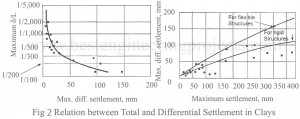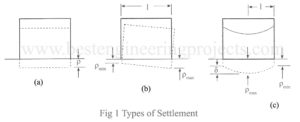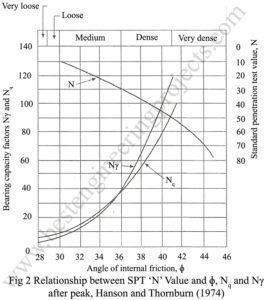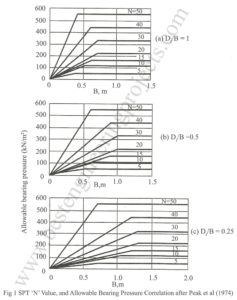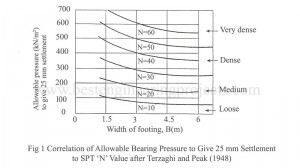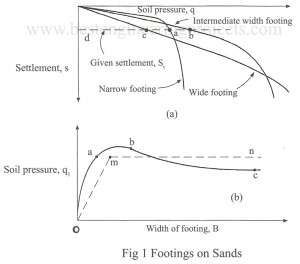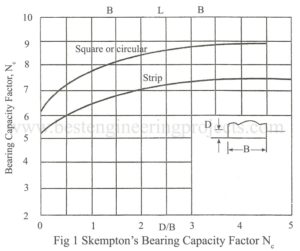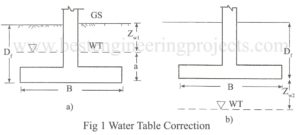Based on actual observations on buildings Bjerrurn (1963) has provided some relationships between total and differential settlement for sands and clay. These are shown in Figs.1 and 2 for sands and clays respectively. It is revealed from the graphs that, in granular soils, the minimum differential settlement can be equal to the maximum permissible settlement. While in clays the differential settlement is much less than the maximum permissible settlement. In sands, the maximum differential settlement seldom exceeds 3/4 of the total settlement, while in clays it seldom exceeds 1/2 of…
Read MoreCategory: Bearing Capacity Theories
Settlement of Foundation | Types of Settlement
Settlement is the vertical displacement from its original level of placement. Settlement has got several implications on a foundation. The implications include: Appearance of structures Utility of structures Damage to the structures Appearance of structures | Settlement of Foundation Settlement affects the appearance of structures. If a structure settles excessively, its aesthetic is impaired. It causes doors and windows to distort, walls and plasters to crack and the structure to tilt. Utility of Structures | Settlement of Foundation Settlement interfere the utility of structures in many ways. If settlement is excessive overhead…
Read MoreTeng’s method | Meyerhof’s method | Bowles method for net safe bearing pressure
Teng’s method – Teng (1962) based on the work of Terzaghi and Peck gave a relationship for allowable bearing capacity for a given permissible settlement. The equation is: qns = 35(N-3){(B+0.3)/2B}2RWRd ———- (1) Where, qns = Net safe bearing pressure, kN/m2 N = SPT value corrected for overburden pressure RW = Water table correction factor Rd = Depth correction factor = 1 + 0.2Df/B ≤1.2 The above equation can also written in general form as: qns = 1.4(N-3){(B+0.3)/2B}RwRdS ———- (2) Where, S = Permissible settlement in mm. Meyerhof’s…
Read MoreModification of Teraghi and Peak Correlation by Peak, Hanson and Thornburn
Peck, Hanson and Thornburn (1974) | Modification of Teraghi and Peak Correlation by Peak, Hanson and Thornburn Peck, Hanson and Thornburn (1974) have modified the original Terzaghi and Peck (1948) recommendations and presented charts as shown in Fig.1 to obtain allowable bearing pressure to give a settlement of 25 mm for a footing of known width, B with its base at a depth, Df resting on a granular deposit in which N (corrected SPT) values are measured. Procedure | Modification of Teraghi and Peak Correlation by Peak, Hanson and Thornburn N (corrected…
Read MoreCorrelation between Corrected SPT(N) and pressure by Teraghi and Peak
Terzaghi and Peck (1948) were the first to propose a correlation between the N (corrected SPT) Value and allowed pressure, by presenting a relationship between the size of a footing, the N (corrected SPT) value, and the applied pressure to give a settlement of 25 mm for a deep ground water table, This correlation is shown in Fig.1 below. Procedure: N should not be corrected with respect to overburden. N should be averaged from the given values. The graph has been developed with the condition that the water table is…
Read MoreBearing Capacity from in Situ Tests
The computation of the bearing capacity from field plate load test has already been discussed in the chapter of site investigation. Here, the discussion will be limited to the estimation of bearing capacity from the results of standard penetration test. Cohesionless soil – In cohesionless soils, the bearing capacity is extremely high with respect to shear failure criteria. In sands, the shear failure criteria govern the capacity only in the case of very narrow footing located in loose sand below water table. In most of the cases the bearing capacity…
Read MoreSkempton’s Theory for Cohesive Soil
Skempton 1951 suggested a bearing capacity theory for saturated clay for which ɸ = 0. Skempton gives Nc, the bearing capacity factor on the basis of theory, laboratory tests and field observations. It was found that the value of Nc increased with the increase in Df/B ratio. The expression for Nc proposed by Skempton is given below. For Strip footings, Nc = 5(1+0.2Df/B), with a maximum limiting value of 7.5 ———- (1) For square and circular footings, Nc = 6(1+0.2Df/B), with a maximum limiting value of 9.0 ———-…
Read MoreHansen’s Bearing Capacity Theory
Hansen 1970 proposed a general bearing capacity equation. This equation is widely used because the equation can be used for both shallow as well as deep foundation. Full scale test on footings has indicated that the Hansen equation gives better correlation than the Terzaghi’s equation. Terzaghi’s equation is known to give conservative results. However, it is still in wide use for its simplicity. The proposed form of the equation is: ———- (1) Table 1 Shape, Depth, load Inclination, Ground and Base Inclination factors. Use term with prime factor when Shape…
Read MoreInfluence of Water table on Bearing Capacity
Terzaghi has developed the bearing capacity equation on the assumption that water table is at great depths. If water table is present close to the foundation, some modification is necessary. This is done as per the followings. Case 1 Water table above footing base The weight of soil below water table is reduced due to buoyancy. The influence of water table on bearing capacity is incorporated in the general bearing capacity equation with the help of Fig.1. Let, Zw1 = Depth of water table below ground level a = Height…
Read MoreFactor Affecting bearing capacity | Granular Soils | Cohesive Soils
What are the factor affecting bearing capacity? The bearing capacity of soil is influenced by various factors. The bearing capacity for cohesive and cohesionless soil is different. The physical features of foundation such as type of foundation, size of foundation, depth of foundation and shape of foundation significantly affect the bearing capacity. The amount of total and differential settlement is one of the main controlling factors for the bearing capacity of the soil. The relative density in the case of granular soil and consistency in the case of cohesive soil…
Read More